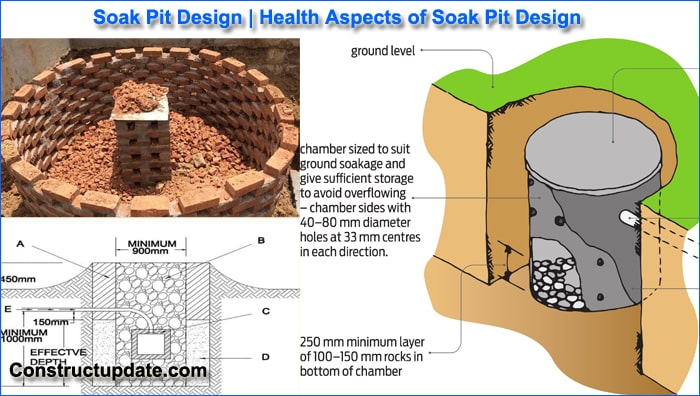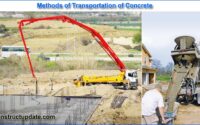Soak Pit Design | What is Soak Pit | Maintenance of Soak Pit | Soak Pit Health Aspects
Soak pits can provide an economical opportunity for a partial treatment of wastewater or ash from a primary treatment (e.g. septic tank, double pits for flush toilets, biogas collector, deflector anaerobic reactor, etc.) and a relatively safe way to discharge it into the environment, thereby recharging groundwater bodies. This is especially true if there is no intention or needs to reuse wastewater, collected rainwater, or greywater.
Small particles are filtered through the soil matrix as wastewater (also known as grey water or black water after primary treatment) seeps into the soil from the immersion well, and organic materials are broken down by microorganisms.
The soil pores allow the waste-water effluent to travel both horizontally and vertically after being absorbed by the soil particles.
Therefore, water must be able to pass through the subsoil layers to prevent quick saturation. Avoid releasing large amounts of discharged effluents each day (HEEB et al. 2008).
Soil with good absorption qualities is better suited for immersion wells; clay, hard, or rocky soil is not ideal.
Leach fields are utilised in the same way as immersion wells, however, immersion wells take up less room and require less upkeep.
They may, however, also be subject to less effect in general, and groundwater contamination may be worse than in leach fields.

Needs of Soak Pit
The wastewater, which is often referred to as greywater, comes from the building’s primary treatment system and includes things like a septic tank, settler, twin-pit latrine, etc. Because it is unclean, it cannot be allowed to seep naturally into the earth.
Before being permitted to settle, the collected effluent must undergo some kind of treatment.
A soak pit is frequently offered for such partial treatment.
The soak pit’s wastewater infiltration can be used to recharge the groundwater.
Design Considerations of Soak Pit Design
The immersion well should be between 1.5 and 4 m deep, but generally speaking, never lower than 2 m above the water table. It essentially consists of a single well (often about 1 m3).
It must be situated at a safe distance from a water supply (preferably more than 30 m).
To prevent compacting of the soil above and around the immersion well, it must be kept out of high traffic areas.
To give support and prevent collapse, it can be left empty and lined with a porous substance, or it can be left unfinished and filled with substantial stones and gravel.
The rocks and gravel will prevent the walls from collapsing, but will still provide adequate space for wastewater.
In all situations, the bottom should be covered with a layer of fine gravel and sand to aid in spreading the flow.
Soak Pits Functions
a. It performs the role of a receiver by gathering the wastewater from the main treatment facility.
b. It enables some degree of purification of the wastewater that has been collected.
c. It permits harmless water to seep into the earth as a result.
d. As a result, it aids in groundwater recharge.
Health Aspects / Acceptance of Soak Pit
Health risks will be limited as long as the preceding collection, storage, and treatment system is in good working order and the immersion well is not used for raw sewage.
Because the equipment is underground, people and animals shouldn’t come in contact with the effluent.
But it’s crucial that the immersion well be placed a safe distance from a water supply (preferably at least 30 m).
Even the most delicate populations must accept the immersion well because it is invisible and odourless.
Operation and Maintenance of Soak Pit
An adequate-sized immersion well ought to last between three and five years without repairs.
Care must be taken to ensure that the effluent has been cleared and/or filtered to avoid an excessive buildup of particulates in order to extend the life of the immersion well.
In order to prevent compacting of the soil above and around the immersion well, it must be kept away from areas with high traffic.
The well will ultimately get clogged with debris and biomass, necessitating cleaning or removal.
The material inside the immersion well can be excavated and replaced as the immersion well’s performance declines.
The pit should be sealed until it needs to be maintained with a removable (ideally concrete) lid to enable access in the future.
Applicability of Soak Pit
Raw sewage cannot be sufficiently treated in a soak pit, which will choke up very soon. Greywater or blackwater that has already been resolved should be discharged through it.
For peri-urban and rural communities, soak pits are suitable. They rely on soil with enough capacity for absorption; however, clay soils, hard-packed soils, or rocky soils are inappropriate.
Although there may be issues with pooling wastewater in locations where the ground freezes, they can be used in practically every climate.
They should be built at least 30 metres away from drinking water wells to prevent cross-contamination. They are not suitable for places with high groundwater tables or flooding risks.
Soak Pit Advantages
- It may be constructed and restored utilising readily available local resources.
- Simple to use a technique for all users.
- A minimal amount of land is needed.
- Low operating and capital costs.
- replenishing groundwater resources.
Disadvantages
- Clogging prevention requires primary therapy.
- may have a deleterious impact on groundwater and soil qualities.
- Only applicable in situations when the groundwater table is at least 5 metres below the soak pit, there is no risk of flooding, and any water wells are at least 30 metres away.
- Cold environment makes it difficult to do.
- For high daily effluent discharge volumes, avoid using.





